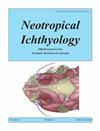耳石形状分析支持三点星形蝶复合体的三个隐种(棘目:海螺科)
IF 2
4区 生物学
Q1 ZOOLOGY
引用次数: 0
摘要
松鱼科(黄花鱼和鼓)以其感觉器官(如耳石和侧线)的特殊化而闻名。在这个家族中,由于其隐秘性和低表型差异,一些星蕨科成员仍未分类。从形态学上看,马斑星是由三个物种组成的物种复合体,但分子数据表明只有两个进化谱系。本文通过耳石的形状和形态对该复合物由Stellifer gomzi (GM)、S. menezesi (MN)和S. punctatissimus (PC)组成的假设进行了验证。采用椭圆傅里叶描述子对77个矢状耳石(GM = 30, MN = 30, PC = 17)进行摄影,勾勒出耳石轮廓。每组各取10块耳石,通过半地标法检测耳蜗沟的形状变化。通过PERMANOVA分析记录了不同物种耳石形状轮廓的差异(伪f = 4.02, df = 2, p < 0.001),并通过线性判别分析证实了这一差异,表明三个部分分离的群体具有令人满意的再分类率。耳蜗沟(GM)和耳蜗沟(MN)较大,呈圆形突起(PC),呈明显的矩形模式。我们的研究结果支持形态假说,从而有助于缩小sciaenae科的分类差距。本文章由计算机程序翻译,如有差异,请以英文原文为准。
Otolith shape analysis supports three cryptic species in the Stellifer punctatissimus complex (Acanthuriformes: Sciaenidae)
Abstract Sciaenidae species (croakers and drums) are known for specializations in their sensory apparatus, such as otoliths and lateral line. Within this family, some Stelliferinae members remain taxonomically unresolved due to their cryptic aspects and low phenotypic disparities. Stellifer punctatissimus comprises a species complex putatively formed by three species on morphological grounds, but molecular data have indicated only two evolutionary lineages. Herein, we tested the hypothesis that this complex is composed of Stellifer gomezi (GM), S. menezesi (MN), and S. punctatissimus (PC), using the otolith shape and morphology to differentiate them. Seventy-seven sagittal otoliths (GM = 30, MN = 30, PC = 17) were photographed to outline the otolith contour by Elliptical Fourier descriptors. Ten otoliths for each group were used to detect shape variation in the sulcus acusticus through semilandmarks. Differences in otolith shape contour were recorded among the species by PERMANOVA (Pseudo-F = 4.02, df = 2, p < 0.001) and corroborated by the Linear Discriminant Analysis, which demonstrated three partially segregated groups with satisfactory re-classification rates. A larger sulcus acusticus (GM and MN), rounded projection (PC), and distinct rectangularity pattern were also recorded. Our results support the morphological hypothesis and thus contribute to narrowing the taxonomic gaps in Sciaenidae.
求助全文
通过发布文献求助,成功后即可免费获取论文全文。
去求助
来源期刊

Neotropical Ichthyology
生物-动物学
CiteScore
2.80
自引率
17.60%
发文量
24
审稿时长
6-12 weeks
期刊介绍:
Neotropical Ichthyology is the official journal of the Sociedade Brasileira de Ictiologia (SBI). It is an international peer-reviewed Open Access periodical that publishes original articles and reviews exclusively on Neotropical freshwater and marine fishes and constitutes an International Forum to disclose and discuss results of original research on the diversity of marine, estuarine and freshwater Neotropical fishes.
-Frequency: Four issues per year published only online since 2020, using the ‘rolling pass’ system, which posts articles online immediately as soon as they are ready for publication. A searchable and citable Digital Object Identifier (DOI) is assigned to each article immediately after online publication, with no need to await the issue’s closing.
-Areas of interest: Biology, Biochemistry and Physiology, Ecology, Ethology, Genetics and Molecular Biology, Systematics.
-Peer review process: The Editor-in-Chief screens each manuscript submitted to Neotropical Ichthyology to verify whether it is within the journal’s scope and policy, presents original research and follows the journal’s guidelines. After passing through the initial screening, articles are assigned to a Section Editor, who then assigns an Associate Editor to start the single blind review process.
 求助内容:
求助内容: 应助结果提醒方式:
应助结果提醒方式:


